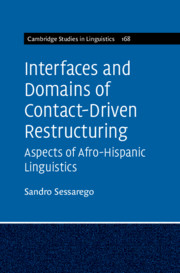Book contents
- Interfaces and Domains of Contact-Driven Restructuring
- Cambridge Studies in Linguistics
- Interfaces and Domains of Contact-Driven Restructuring
- Copyright page
- Dedication
- Contents
- Figures
- Maps
- Tables
- Acknowledgments
- 1 Questioning a Long-Lasting Assumption in the Field
- 2 The African Diaspora to the Andes and Its Linguistic Consequences
- 3 Reconciling Formalism and Language Variation
- 4 Variable Phi-Agreement across the Determiner Phrase
- 5 Partial Pro-Drop Phenomena
- 6 Early-Peak Alignment and Duplication of Boundary Tone Configurations
- 7 Final Considerations
- References
- Index
2 - The African Diaspora to the Andes and Its Linguistic Consequences
Published online by Cambridge University Press: 21 October 2021
- Interfaces and Domains of Contact-Driven Restructuring
- Cambridge Studies in Linguistics
- Interfaces and Domains of Contact-Driven Restructuring
- Copyright page
- Dedication
- Contents
- Figures
- Maps
- Tables
- Acknowledgments
- 1 Questioning a Long-Lasting Assumption in the Field
- 2 The African Diaspora to the Andes and Its Linguistic Consequences
- 3 Reconciling Formalism and Language Variation
- 4 Variable Phi-Agreement across the Determiner Phrase
- 5 Partial Pro-Drop Phenomena
- 6 Early-Peak Alignment and Duplication of Boundary Tone Configurations
- 7 Final Considerations
- References
- Index
Summary
Chapter 2 provides a sociohistorical analysis of the evolution of Yungueño Spanish, Chota Valley Spanish and Chincha Spanish. The chapter illustrates general aspects of the African Diaspora to the Americas and its specific linguistic consequences in Yungas (Bolivia), Chota Valley (Ecuador) and Chincha (Peru). Given the historical evidence available for these Afro-Hispanic Languages of the Americas, I propose that these contact varieties developed in isolated rural villages, not subject to the social pressures imposed by education, standardization and the linguistic norm. In such a context, advanced SLA processes could be nativized and conventionalized at the local level, thus crystallizing in the L1 varieties spoken by subsequent generations of these Afro-Andean communities.
- Type
- Chapter
- Information
- Interfaces and Domains of Contact-Driven RestructuringAspects of Afro-Hispanic Linguistics, pp. 35 - 56Publisher: Cambridge University PressPrint publication year: 2021

